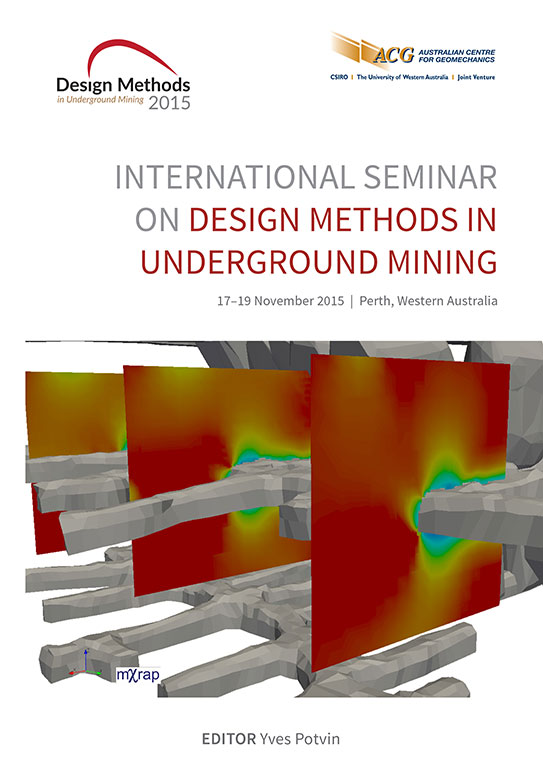Empirical ground support and reinforcement design at Challenger Gold Mine

|
Authors: Hills, PB; Raymond, N; Doyle, M |
DOI https://doi.org/10.36487/ACG_rep/1511_23_Hills
Cite As:
Hills, PB, Raymond, N & Doyle, M 2015, 'Empirical ground support and reinforcement design at Challenger Gold Mine', in Y Potvin (ed.), Design Methods 2015: Proceedings of the International Seminar on Design Methods in Underground Mining, Australian Centre for Geomechanics, Perth, pp. 385-398, https://doi.org/10.36487/ACG_rep/1511_23_Hills
Abstract:
Empirical methods form the basis of design for ground support and reinforcement of development at the Challenger Gold Mine (CGM) in South Australia. In a general sense, the rock mass conditions at CGM are very good. In situ rock stress is low relative to most Australian conditions with near hydrostatic conditions at a depth of 1,000 m, and the rocks themselves are strong and competent. As a consequence of the generally favourable geotechnical conditions, the design of ground support and reinforcement for mine development areas is heavily reliant on the use of empirical methods. Detailed geological and geotechnical mapping is undertaken in all headings, and particularly at the site of proposed intersections. The rock mass is characterised using the Q-System, and various techniques are used to determine the appropriate assignment of the base parameters. As an example, rock quality designation (RQD) is interpreted from threedimensional contouring of diamond drill data and crosschecked against volumetric joint counts. Standard patterns for ground support and reinforcement are applied when the rock mass is characterised as ‘good’ or ‘fair’. Characterisation of the rock mass as ‘poor’ triggers site specific design to suit the prevailing conditions. All design is augmented by kinematic wedge analysis and geological observation. Currently, CGM ground support and reinforcement designs target a Factor of Safety (FS) of at least 1.5 in static conditions with an overriding dynamic capacity in excess of 5 kJ/m2. In recent years, considerable effort has been placed on optimising the empirical designs while maintaining the overall integrity of the process. This has led to a significant reduction in use of consumables through the optimised use of geotechnical engineering.
References:
Androvic, P, Bamford, P, Giles, A, Derwent, K, Kopeap, P, Hampton, S, Heydari, M, Curtis, J, Sperring, P & Gobert, R 2013, ‘Challenger Gold Mine’, in WJ Rankin (ed.), Monograph 28 — Australasian mining and metallurgical operating practices, The Australasian Institute of Mining and Metallurgy, Melbourne, 3rd edn, pp. 1097-1112.
Barton, NR, Lien, R & Lunde, J 1974, ‘Engineering classification of rock masses for design of tunnel support’, Rock Mechanics and Rock Engineering, vol. 6, no. 4, pp. 189-236.
Barton, NR, Løset, F, Lien, R & Lunde, J 1980, ‘Application of the Q-system in design decisions concerning dimensions and appropriate support for underground installations’, in M Bergman (ed.), Proceedings of the International Symposium (Rockstore '80), Subsurface space environmental protection, low cost storage, energy savings, Pergamon Press, New York, NY, pp. 553-561.
Bastian, T 2013, Geotechnical competency investigation - backs fracturing and half-barrelling, Kingsgate Consolidated Limited, Sydney.
Deere, DU, Hendron, AJ, Patton, FD & Cording, EJ 1967, ‘Design of surface and near-surface construction in rock’, in C Fairhurst (ed.), Proceedings of the 8th US Symposium on Rock Mechanics (USRMS), American Rock Mechanics Association, Minneapolis, MN, pp. 237-302.
Faint, L 2010, Backs fracturing investigation, Dominion Mining Limited, Perth.
Hutchinson, DJ & Diederichs, MS 1996, Cablebolting in underground mines, BiTech Publishers, Richmond.
Kaiser, PK, McCreath, DR & Tannant, DD 1996, Canadian rockburst support handbook, Geomechanics Research Centre,
Sudbury, ON.
Kirsten, HAD 1983, ‘The combined Q-NATM system — the design and specification of primary tunnel support’, South African Tunnelling, vol. 6, no. 1, pp. 18-24.
Mining Measurement Services 2006, Challenger Gold Mine rock stress measurement 780SP, Mining Measurement Services Pty Ltd, Macclesfield.
Mining Measurement Services 2008, Challenger Gold Mine rock stress measurement jumbuck decline 580 external SP, Mining Measurement Services Pty Ltd, Macclesfield.
Mining Measurement Services 2011, Challenger Gold Mine rock stress measurement 320 DD, Mining Measurement Services Pty Ltd, Macclesfield.
Norwegian Geotechnical Institute 2013, Using the Q-system handbook: rock mass classification and support design, Norwegian Geotechnical Institute, Oslo.
Palmström, A 1982, ‘The volumetric joint count - a useful and simple measure of the degree of rock jointing’, Proceedings of the 4th IAEG Congress, International Association of Engineering Geology (IAEG), pp. 221-228.
Pender, EB, Hosking, AD & Mattner, RH 1963, ‘Grouted rock bolts for permanent support of major underground works’, Journal of the Institution of Engineers (Australia), vol. 35, no. 7, 22 p.
Shach, R, Garshol, K & Heltzen, A 1979, Rock bolting, a practical handbook, Pergamon Press, New York, NY.
Western Australian School of Mines 2006, Report on intact rock properties for Dominion Gold Pty Ltd — Challenger Gold Project, report, prepared for Western Australian School of Mines, Kalgoorlie.
© Copyright 2025, Australian Centre for Geomechanics (ACG), The University of Western Australia. All rights reserved.
View copyright/legal information
Please direct any queries or error reports to repository-acg@uwa.edu.au
View copyright/legal information
Please direct any queries or error reports to repository-acg@uwa.edu.au